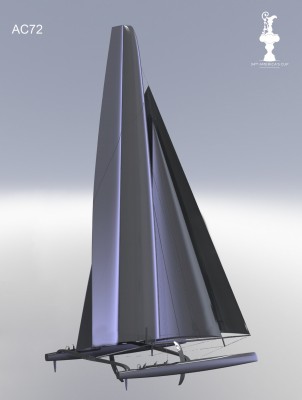More breaking Cup news - draft rule revealed, along with two key staff appointments
Hot on the heels of the major announcement about the 34th America’s Cup and the radical changes that will take place for the 2013 event, the draft rules for the 72ft wingmasted catamaran have just been released.
The move to multihulls for the next cycle of the America’s Cup is the most radical change in the history of this prestigious event and one that will no doubt prove to be one of the most controversial too. Next year sees Challengers race one design 45ft wing masted catamarans at three international events.
From 1 January 2012, teams will be able to launch the first of a maximum of two 72ft cats. These boats will be designed to a box type rule, the draft details of which we re released today and can be downloaded at www.americascup.com.
The new AC72 class is the first-ever wingsail catamaran class for the America’s Cup and the fastest-ever class in the iconic 159-year-old competition. It replaces the ACC monohull class, which was created in 1988 and first raced in 1992 Cup.
The new boats will make their racing debut in the 2012 season for the America’s Cup World Series ahead of the 34th Match in 2013.
A catamaran was selected as one element to transform and enliven the America’s Cup for the future. A multihull is the ideal dynamic class, capable of being raced hard in winds from 5 to 30 knots to minimize racing delays due to winds too light or too strong.
AC72 design parameters:
LOA 22.0 meters (72 feet)
Beam 14.0 meters (46 feet)
Displacement 5,700 kilograms (12,500 pounds)
All-up weight 7,000 kilograms (15,500 pounds)
Wingsail area 260 square meters (2,800 square feet)
Wingsail height 40 meters (130 feet)
Wingsail chord 8.5 meters (28 feet)
Sail trimming Manual grinders
Configuration Twin-hulled catamaran
Crew 11
Sail trimming No mechanically powered systems
Sail area reduction Removable top sections/leech elements
Appendages Maximum of 2 rudders, 2 daggerboards
Construction Minimum 600 grams/square-meter outer-skin;
High-modulus carbon-fiber permitted in wingsail spar
The AC72 Class Rule was drafted by a distinguished group of consultants, chaired by Pete Melvin, on behalf of US SAILING.
Melvin, formerly a designer of aircraft for the McDonnell Douglas Corp. is a champion multihull sailor, having twice won the A Class Catamaran World Championship. Morrelli & 2
Melvin Design & Engineering, Inc., also designed the record-setting maxi catamaran PlayStation.
Organizers of the 34th America’s Cup believed it was essential that the first new class of boat to be introduced since 1992 should be developed independent of any of the teams competing. A Concept Brief was published in June setting out the performance and operational requirements.
The AC72 is a “box rule.” This narrows down the design parameters so that while teams have freedom to create their own boats, they will be similar in dimensions in order to ensure close racing.
Hulls and beams will have to be assembled in two days and disassembled in one to allow America’s Cup teams to move efficiently between venues. Replaceable “crumple zone” bow and stern cones will allow for quick repair in the in the cut-and-thrust of racing.
To fast-track all teams to a common level of technology, a new, smaller class of identical wingsail catamaran, the AC45, will be used for the 2011 ACWS season while teams create their new high-performance catamaran.
To ensure the fairest possible competition for the 34th America’s Cup, the draft of the AC72 rule is being made available to teams for feedback before it is finalized. A similar process was used to create the Protocol for the 34th America’s Cup.
Also revealed today, are two key roles, that of Iain Murray as Regatta Director and Andy Hindley as Chief Operating Officer.
Murray (52, Sydney, Australia) heads up the new America’s Cup Race Management (ACRM), holding the dual role of CEO of the independent organization.
This is the first time in the event’s 159-year history that the defender has divested management of the competition into the hands of a neutral body, a central part of its vision to move the America’s Cup into the future.
ACRM will have responsibility over a wide range of topics including budget, management of the new AC72 and AC45 classes, the Youth America’s Cup (slated for 2012), the International Jury, race committee, umpires and measurement committee.
ACRM also will oversee the operation of a meteorological and oceanographic data service, the establishment and management of the America’s Cup Village, and infrastructure at all America’s Cup World Series (ACWS) venues.
Murray, a figurehead in America’s Cup syndicates from 1983 to 1995, has held a vision of an independent management body for the past 20 years.
Joining Murray in ACRM as the Chief Operating Officer is Andy Hindley, former Race Manager of the Volvo Ocean Race. 2
Hindley (43, Hampshire, UK) managed the 2001-02 and 05-06 editions of the Volvo Ocean Race before becoming in 2008 the Race and Technical Director of Powerboat P1 Management, the offshore monohull powerboat championship, for two years.
Hindley’s personal racing background is based largely in round-the-world races. Hindley, who holds a degree in physics, has a strong background in logistics from his days with the Volvo Ocean Race and P1 Powerboats.
Matthew Sheahan’s analysis of the news in his report from the announcement in Valencia
Subscribe to Shoretalk for Free
Receive Shoretalk automatically as soon as each programme is published, ready for download to your iPod, phone, computer or any mp3 player.
Simply CLICK HERE TO SUBSCRIBE and select the application that you would like to use to download the podcasts automatically, eg. iTunes.




